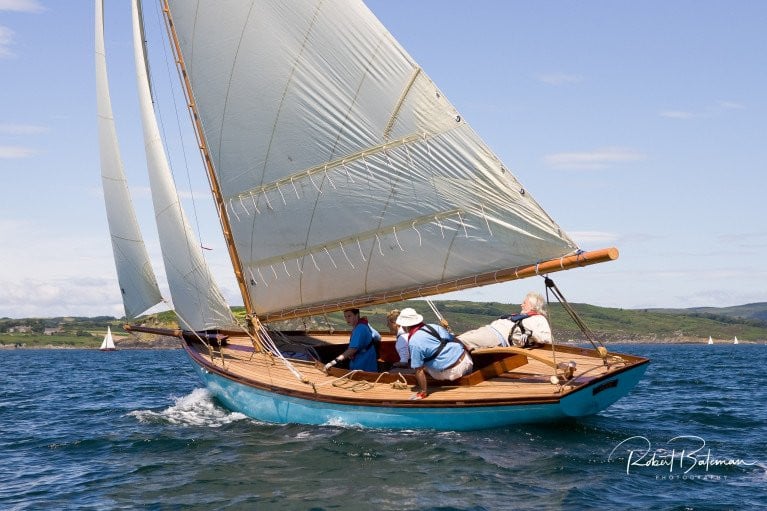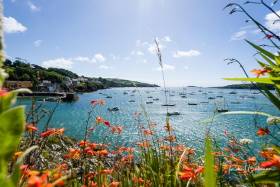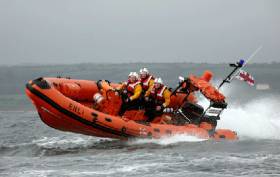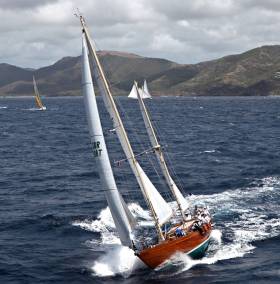Displaying items by tag: Glandore Harbour
A rare sight was caught on camera this past week with the birth of a bottlenose dolphin in Glandore Harbour.
Following reports on Monday (15 April) to the Irish Whale and Dolphin Group (IWDG) of a large gathering near Mizen Head of some 25 bottlenoses — a dolphin species not frequently seen off West Cork — a second similar-sized group was spotted two days later some 60km to the east at Glandore.
Local IWDG member Heather Mahmood flew her drone over the Glandore pod to capture some footage and images, and upon reviewing the results with her daughter Ruá on Thursday evening, the pair were surprised to discover what appeared to be a dolphin giving birth.
After sending the footage and images to the IWDG, sightings officer Pádraig Whooley came to the same conclusion.
“[It appeared] that it was indeed a female either giving birth or in the process of, as the appendage [seen protruding from the dolphin] looked very similar to a tiny, floppy tail fluke,” Whooley said.
“It is known that to maximise the chance of a successful birth, which can be a long process for all mammal species, cetacean calves are born tail-first. This is an adaptation to living in an aquatic environment, as it gives the new born the maximum breathing time inside the birth canal — that first breath being the critical one.”
Whooley referred to the IWDG’s resident experts on bottlenose dolphins, Simon Berrow and Mags Daly of the Shannon Dolphin Project, who were just as astounded.
“Neither of them have ever witnessed the birth of a bottlenose dolphin, despite being involved in monitoring the resident Shannon population now for over 30 years,” Whooley said.
“In fairness, how could they have, as this behaviour could really only be detected from an aerial perspective, which we now have at our disposal.”
The IWDG shared their findings with Cromarty-based Dr Barbara J Chaney, who studies the Scottish bottlenose population that overlaps with our own, “and her thoughts mirrored ours, that this footage was unique, both in a British and Irish context, as this event has never before been seen, let alone recorded,” Whooley added.
See the remarkable video on the IWDG website HERE.
The ‘Celtic Challenge’ will be raced in Glandore, West Cork this weekend, June 17/18. It is held annually, alternating between the Glandore Harbour Yacht Club and the Royal Anglesey Yacht Club of Wales.
The format is Admiral’s Cup style team racing under regular racing rules of sailing in International Dragons provided by GHYC in Glandore and in Fife Menai Straits One Designs when in Anglesey provided by RAYC. Two club teams sail four boats each, drawn by lot and exchanged on the second day. Each is crewed by a minimum of three, one of which is an owner’s caretaker.
The regatta dates back to 2005 when RAYC members trailed their Straits One Designs to Glandore for the GHYC Classic Regatta and came again in subsequent years. From that, the Celtic Challenge developed. A perpetual trophy was presented by Eamon Timoney of Fehily Timoney and Company, a Glandore Dragon sailor. It was won last year by the Welsh club. This year’s event is sponsored by Heineken, with Glandore YC determined to wrest the trophy back in home waters.
Bendon's 'MarJ' Wins Glandore Harbour's Lar Casey Cup for Dragons
The 40th anniversary of the Lar Casey Cup for Dragons was won by Adrian Bendon’s MarJ at Glandore Harbour YC in West Cork.
Second was Ghost, C.Dunne and C.Daly and third Little Fella, Cameron Good.
The original event was also won by Adrian.
In normal years, the Lar Casey Cup is sailed on the Saturday of the Glandore Regatta but for the 40th Anniversary, the event was expanded to two days with 3 races Saturday and 2 on Sunday. The local fleet of 11 Dragons was boosted by 8 visiting Dragons from Dublin and Kinsale some of whom were previous winners of the Lar Casey Cup.
The conditions on Saturday were very light for racing outside the harbour but Race Officer David Forde, assisted by Mary O’Sullivan and Emily Jane O’Mahony, was able to set the windward leeward course and got in the scheduled 3 races. Race winners on the day were Moonshine and Mar J (2) and overall leader Mar J. For the last race of the day after the second general recall the black flag was raised and Phantom and Aphrodite were called out and sent home early.
On Sunday the conditions were even lighter but the fleet was sent out to sit through a one hour postponement until a sea breeze 4-5kts appeared. The course was set in the outer harbour with club mark Goat as windward mark and a finish in the inner harbour opposite Casey’s Bar. The breeze dropped soon after the start and made it a challenge to get to the windward mark. For the run it looked like the middle of the harbour was favoured with more breeze but the boats that hugged the shore fared better. Race winner on the day was Pongo, a previous Lar Casey Cup winner. Mar J finished 4th to secure overall winner. Mar J helm Adrian Bendon, a long time previous resident of Glandore, sailed as crew on Pan, winner of the first race for the Lar Casey Cup! Crewing on Mar J was Shawn Kingston, also a previous winner.
Casey’s Bar sponsored the event and provided all the prizes for individual race winners and the overall 1st, 2nd, and 3rd, with a special prize for oldest wooden boat, Gypsy, sailed by Don Street, also a previous winner of the Lar Casey Cup. Dinner on Saturday night and snacks on Sunday prize giving were also provided by Casey’s Bar.
You may remember a little while back, we were recording the sad yarn of Don Street losing his beloved vintage clinker-built service tender Red Rocket when a freakish October gale swept over Glandore pier, and removed everything in its way, including boats stowed where they’d been safely stowed for many a year. Well, Red Rocket was among them, gone to smithereens after 41 years of faithful service. But after a farewell libation or two in honour of her memory at the outer pierhead as soon as things had settled down a bit, 90-year-old Don set to with an almost nationwide search for something similar, as he wouldn’t dream of bringing anything manufactured in synthetic rubber alongside his beloved vintage International Dragon Gypsy.
We thought the search had become too intense when we got a brief email from him recently saying he’d got the dengue, for dengue fever is no laughing matter. But it turned out that the accursed predictive text, which those of us bewildered by much of modern IT find a hellish nuisance at the best of times, had struck yet again. It seems Don was only in a bit of a rush to tell everyone that he had the dinghy, that his son Richard in West Wicklow had managed to acquire possession of an ideal dinghy which had been sourced via the more obscure corners of the internet by the man who is the real foundation of just about everything worthwhile that has happened in Glandore for several decades, the Blessed Kieran O’Donoghue of the Glandore Harbour Inn and much other good work that is largely done by stealth.
The circumstances were such that this 14ft edge-glued epoxied sweety had to be taken untested. But Richard like his father has an eye for a boat - as too had Kieran O’D in viewing the first vague image on-screen - so it wasn’t until now that Richard felt he’d be within the pandemic regulations taking the new boat for a test row on Blessington Lake, aka Lough Poulaphouca, where he is one of the stalwarts of the thriving GP14 class. The photo says it all. Thanks to the clever construction, she’s as light as a feather, thanks to the classic design the transom sits properly clear of the water when there’s just a solo oarsman aboard, and yet it’s obvious she’ll be capable of carrying a good load when required, and at a handy speed too.
So despite the pandemic, the job has been done - and done well.
Glandore Classics Regatta Another Victim of Coronavirus
Glandore Harbour Yacht Club has cancelled its Classic Regatta which had been scheduled to start on July 18.
Since it was first held on a July weekend in 1992 Glandore Classic Boats Regatta has developed into an outstanding event, “where the masterpieces of the great age of sail mingle with traditional West Cork workboats for a regatta of sailing and spectacle.”
This year’s event was intended to join with the Tricentenary celebrations of the Royal Cork Yacht Club’s 300 years, having been postponed from last year, which would have been its normal two-year cycle schedule.
So the decision by the committee of Glandore Harbour Yacht Club to postpone the event is a double “whammy” and will also be a big blow to the local tourist economy.
There wasn’t much alternative.
Sailing Secretary, Hal Andrews, told Afloat the reasons: “Social distancing requirements affect our ability to provide support and safety boat cover, ferry boat services, all social activities, club facilities, etc. We would have had to postpone, anyway, under current Irish Sailing ‘Back-to-Sailing plans. And it is impossible to know whether a return to lockdown definitely will not happen. We will make a decision later about whether to reschedule for 2021 or 2022, to link again to Cork 300 as originally planned.”
The combination of a new venue for a gathering of classic boats – Glandore Harbour’s natural amphitheatre, a warm welcome and the growing interest in traditional boats, contributed to the success of event after its first year. That had attracted a fleet of local and visiting traditional and classic boats. The original ‘Parade of Sail’ has been a strong spectator and visitor feature since the outset that has always been included and the ‘Classics’ has survived some turbulent weather conditions.
After the Millennium the biennial cycle regatta was re-titled Glandore Classic Regatta. While the Traditional and West Cork Mackerel Yawls and Lobster boats formed the backbone of the event, the regatta attracted a fleet of classic yachts, one-designs and classic day-boats. In following regattas, the Water Wags arrived from Dublin Bay to showcase formation sailing under the baton of Hal Sisk. The first of the Heir Island Sloops and the revived Cork Harbour One-Designs participated. The Fastnet Race for bigger boats was added to the programme. The Castletownshend ETTE Class raced, Howth 17’s took part as well as Conway Fifes, Shannon One-Designs and Classic Dragons as interest in the regatta expanded.
“An outstanding event where the masterpieces of the great age of sail mingle with traditional West Cork workboats for a regatta of sailing and spectacle. A ‘must-see’ on the sailing calendar for connoisseurs of classic, traditional or even just plain odd boats, it’s a feast for the eye, the memory with vividly contrasting boats all united in at least one purpose,” was one of the descriptions lavished on the event, I’ve had the pleasure of sailing in it several times aboard the late Guy Perrem’s MAB out of Monkstown Bay, which brought great pleasure to him when she took prizes back to Cork Harbour a number of times.
This year’s event was set to be the biggest and most exciting of the series as Glandore Harbour YC partnered with the RCYC’S Cork 300 with the possibility of bringing outstanding classic boats from around the world to the West Cork coast.
Its postponement is another of the long list of sailing event casualties due to the current health pandemic.
Listen to the podcast below
Glandore Classic Regatta 2020 Will Run from July 18-25
Since 1991 the scenic Glandore Harbour has seen some of the most elegant classic yachts coming together for racing and craic on shore.
Organisers say the reason why so many classic yachts keep coming back to Glandore is that it offers an unbeatable combination of one of the most beautiful natural harbours in the world, highly competitive racing, expertly organised, plus very relaxed friendly evening entertainment in the best West Cork tradition.
The Royal Cork Yacht Club will be celebrating its 300th anniversary during the week before Glandore. The close link with Cork 300 as well as with the Fife and Cowes Classic Regattas has generated unprecedented interest from the bigger classic yachts many of whom are extending their visit to the Irish south coast in order to cruise west and take part in the Glandore Classic Regatta 2020.
Teen Anglers Rescued In Glandore Harbour By Union Hall Lifeboat
#RNLI - Union Hall RNLI were tasked yesterday evening (Friday 11 August) by Valentia Coast Guard to a 16ft pleasure craft with five teenagers aboard that suffered engine failure in West Cork’s Glandore Harbour.
The lifeboat was launched and underway at 6.05pm to go to the aid of the casualty vessel, whose passengers had been angling at the eastern entrance of the harbour.
In favourable weather conditions, the Union Hall lifeboat was on scene within a few minutes to assist the pleasure craft as its position was a mere 15 feet away from rocks.
Following the incident, the five teenagers and their parents called to the lifeboat station to thank the volunteer crew for coming to their aid.
Martin Limrick, Union Hall RNLI volunteer lifeboat crew member, said: “The teenagers did everything right. They rang for help, deployed their anchor and were all wearing lifejackets.
“We would urge people when heading out on the water to have a means of communication, always wear a lifejacket and to respect the water.”
With just twelve days to go to the start of the 25th Anniversary Glandore Classic Boat Regatta 2017 from July 23rd to July 28th, Glandore Harbour Yacht Club are swinging all systems into action with the extra muscle provided by sponsorship writes W M Nixon. As ever, the theme will be variety, with the pace in sheer style being set by elegant craft such as the 1970-vintage all-varnish 55ft McGruer ketch Cuilaun (Brian Smullen & Michael O’Flaherty).
She’s a fine ship which, in her day, has won her class in a Transatlantic Race to Cork. But then at the other end of the spectrum in terms of size and detail, there will be a host of boats representing the strong Traditional Boat theme which is central to West Cork sailing and rowing.
And this time round, there’ll be an unprecedented level of input from the Shannon Estuary, including the Theo Rye-designed CityOne dinghies from Limerick.
Internationally, the late naval architect and maritime historian Theo Rye was noted as the ultimate authority in everything to do with real classics right up to such giants as the Fife 23 Metre Cambria. But he was a man of many and inventive talents, and when his friend Gary MacMahon of the Ilen Boat-Building School in Limerick requested some ideas for an easy-to-build sailing dinghy whose construction would fit neatly into the school’s curriculum, Theo came up with the CityOne concept.
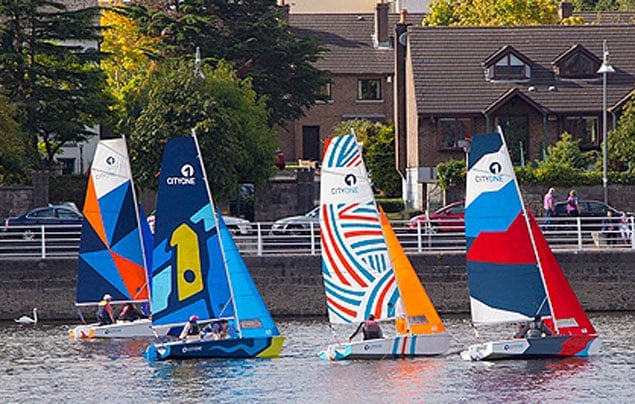 CityOne dinghies on the Shannon in Limerick. Designed by Theo Rye, built by the Ilen School, and with their sail colour schemes selected by international competition, they will be in Glandore to honour the memory of the late Theo Rye. Photo: W M Nixon
CityOne dinghies on the Shannon in Limerick. Designed by Theo Rye, built by the Ilen School, and with their sail colour schemes selected by international competition, they will be in Glandore to honour the memory of the late Theo Rye. Photo: W M Nixon
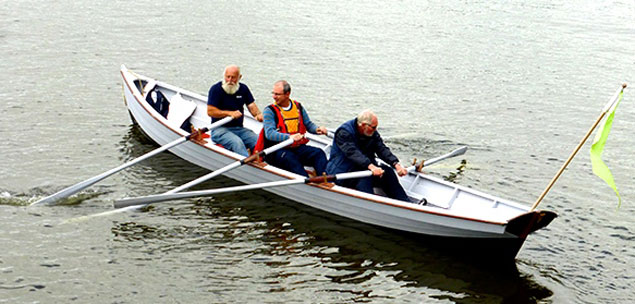 The late Theo Rye (centre) rowing one of the Ilen Boatbuilding School’s gandelows in the heart of Limerick. In the bow is Liam O’Donoghue, while the third oarsman is Hal Sisk. Photo: W M Nixon
The late Theo Rye (centre) rowing one of the Ilen Boatbuilding School’s gandelows in the heart of Limerick. In the bow is Liam O’Donoghue, while the third oarsman is Hal Sisk. Photo: W M Nixon
With vivid sail colour design schemes which resulted from a global internet competition run from Limerick, the CityOnes are a visually-striking and functionally successful concept. Yet they’re probably not what many would have expected from Theo’s drawing board. But as it was typically generous of him to provide the very innovative design, and now the very existence of the CityOnes is a Theo memorial following his untimely death last year. Thus their racing at Glandore will be part of a celebration of the life and contribution of Theo Rye, both in the world of classics, and in his generous and often unusual ideas in all the areas with which he became involved.
Also coming to Glandore from the Ilen School in Limerick will be the flotilla of trainee-built 23ft gandelows, which have revived the Shannon Estuary’s fleet of these uniquely-local mud-sliding boats. But although their flat-bottomed mud-sliding capacity is key to their design, they’re attractive boats in their own right. As a result, Patrick Beautement from England was so inspired by the Ilen School’s ethos after working there as a volunteer that he has built a 15ft version of the gandelow in deepest Gloucestershire, and she’ll be making her debut at Glandore.
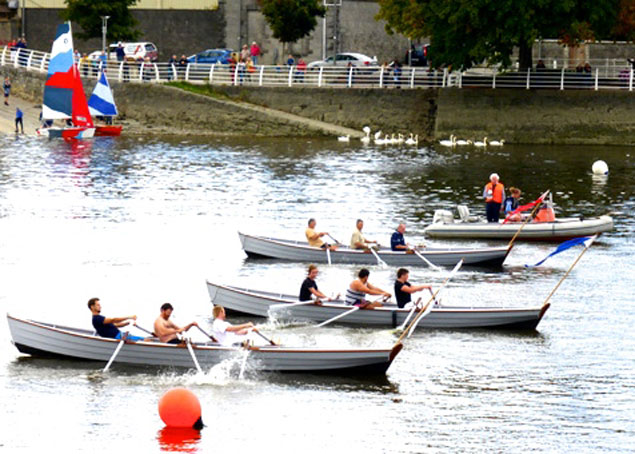 Although the gandelow was developed as a Shannon Estuary work and fishing boat capable of being slithered across mud, the Ilen Boatbuilding School’s scheme has resulted in the new fleet developing a racing programme. Photo: W M Nixon
Although the gandelow was developed as a Shannon Estuary work and fishing boat capable of being slithered across mud, the Ilen Boatbuilding School’s scheme has resulted in the new fleet developing a racing programme. Photo: W M Nixon
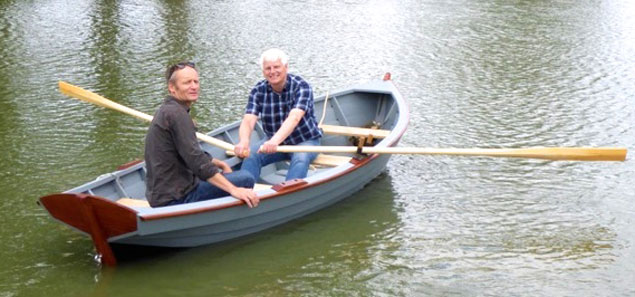 This “mini-gandelow”, just 15ft long, will be at Glandore. She was built in Gloucestershire in England by Patrick Beautement, who had worked as a volunteer in the Ilen Boat Building School in Limerick
This “mini-gandelow”, just 15ft long, will be at Glandore. She was built in Gloucestershire in England by Patrick Beautement, who had worked as a volunteer in the Ilen Boat Building School in Limerick
But the influence of the Shannon Estuary doesn’t stop there, as another Glandore debutante will be the characterful 25ft cutter Sally O’Keeffe from Kilrush. She was built as a community project in Querrin on the south shore of the Loop Head Peninsula in a successful attempt to re-create the sailing hookers of the Shannon Estuary which served the many little local ports such as Querrin in times past. Naval architect Myles Stapleton gave the Querrin folk a wonderful design which draws its inspiration from the old vessels, but adds a little bit of its own magic stardust for a fine little ship which will be sailing from Kilrush to Glandore.
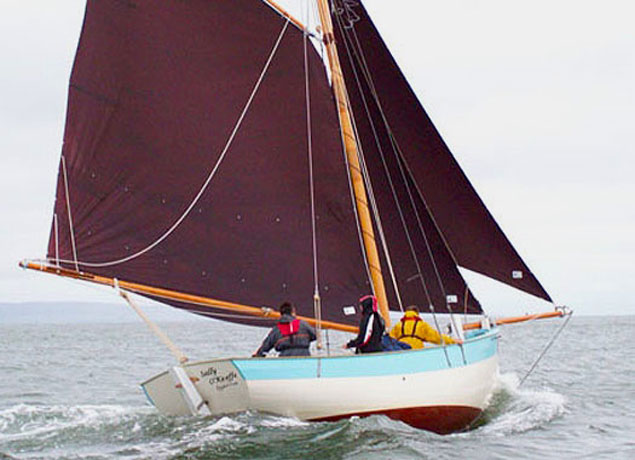 The attractive 25ft cutter Sally O’Keeffe of Querrin will be sailing the long oceanic haul from Kilrush to Glandore for the Classic Regatta
The attractive 25ft cutter Sally O’Keeffe of Querrin will be sailing the long oceanic haul from Kilrush to Glandore for the Classic Regatta
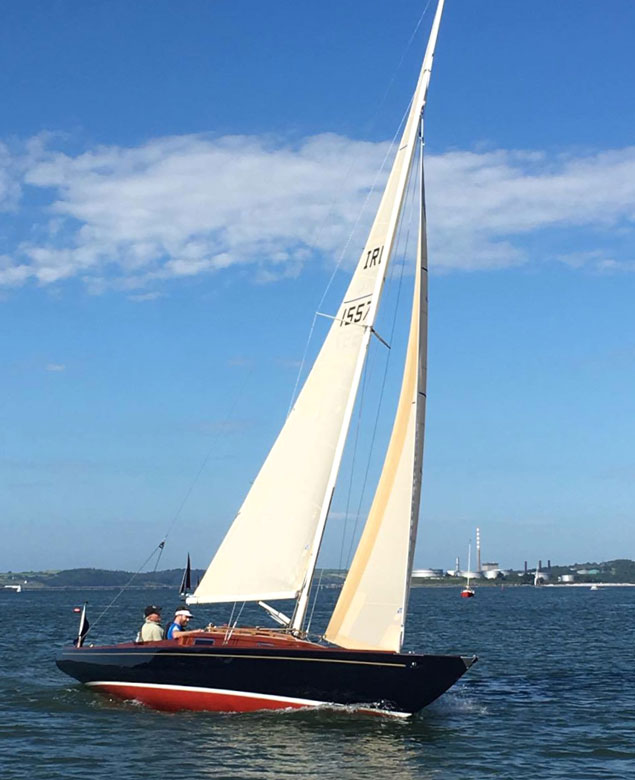 etchells guapa7 The classics experts at Glandore will be keen to give their opinions on Guapa, the extraordinary re-configuration of an Etchells 22 by Bill Trafford of Alchemy Marine.
etchells guapa7 The classics experts at Glandore will be keen to give their opinions on Guapa, the extraordinary re-configuration of an Etchells 22 by Bill Trafford of Alchemy Marine.
While it was a shed in Querrin that produced the Sally O’Keeffe, another distant shed away to the eastward at Skenakilla Crossroads in north Cork near Mitchelstown saw the irrepressible Bill Trafford working away on what started as a standard Etchells 22 of a certain age, but has emerged a year later as the unique and very elegant Guapa, an astonishing transformation which will certainly find people in Glandore who will appreciate the time and talents that have gone into her creation.
But in addition to modern twists on classic themes, Glandore Harbour will be well populated by what we might call classic classics, with the pace being set by the locally-based fleet of Classic International Dragons, which set so many records in terms of racing longevity and major international trophies won far back in the previous Millenium that it’s arguable that they should be a listed species.
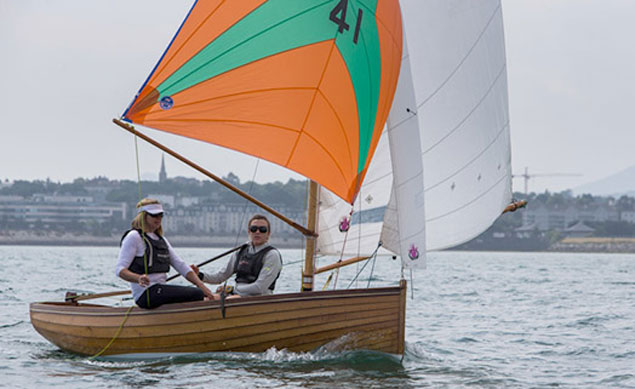 Cathy MacAleavey (left) sailing a family Water Wag with her daughter, Olympic Silver Medallist Annalise Murphy. The lines of the current Water Wag fleet were drawn in 1900 by a woman designer, Maimie Doyle, daughter of builder James E Doyle of Kingstown.
Cathy MacAleavey (left) sailing a family Water Wag with her daughter, Olympic Silver Medallist Annalise Murphy. The lines of the current Water Wag fleet were drawn in 1900 by a woman designer, Maimie Doyle, daughter of builder James E Doyle of Kingstown.
Another even more vintage racing class of 100% Irish origins that has already been strutting its stuff big time in 2017 at both the Semaine de Morbihan in Brittany at the end of May, and the recent Dun Laoghaire Regatta in Dublin Bay, is the Water Wags from Dun Laoghaire. They expect to muster nine boats at Glandore. And in addition to including many noted women sailors with the Murphy/MacAleavey family in particular making a big input, it should never be forgotten that when the original 13ft Water Wags of 1887 vintage decided to trade up to a larger 14ft-plus dinghy in 1900, the new design was by a woman.
The order for their construction may have gone to noted Kingstown boatbuilder James Doyle, yet it was his talented daughter Maimie who actually designed the boats. But then, the Water Wags were always ahead of their time, and the word is that in Glandore they’ll be demonstrating their special skill at Synchronised Sailing. This may tempt the Ette Class visiting Glandore from Castletownshend next door to try something similar, but we’re told it’s not as easy as it looks.
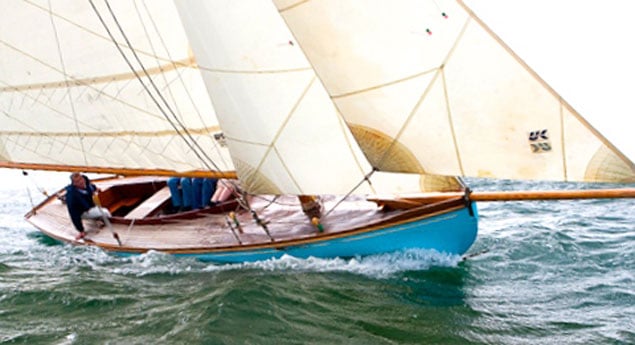 No Classic Regatta would be complete without a design by William Fife, and Patrick Dorgan’s Cork Harbour One Design Elsie, which will be at Glandore, is of a Fife-designed class that first raced in 1896.
No Classic Regatta would be complete without a design by William Fife, and Patrick Dorgan’s Cork Harbour One Design Elsie, which will be at Glandore, is of a Fife-designed class that first raced in 1896.
The great name of William Fife as a designer will also be present with the 1905 Clyde Thirty Brynoth, and the Cork Harbour One Design Elsie (Patrick Dorgan), of a time-honoured design which first appeared in 1895-96.
From time to time, these golden oldies benefit from the attention of sympathetic and highly-skilled boatbuilders who understand their special needs, and West Cork is well-filled with such talent, with Rui Ferreira near Ballydehob emerging at Glandore to show his skills with his restored 1936-vintage Flying Fish, which he somehow finds time to work on between skilled jobs for other people.
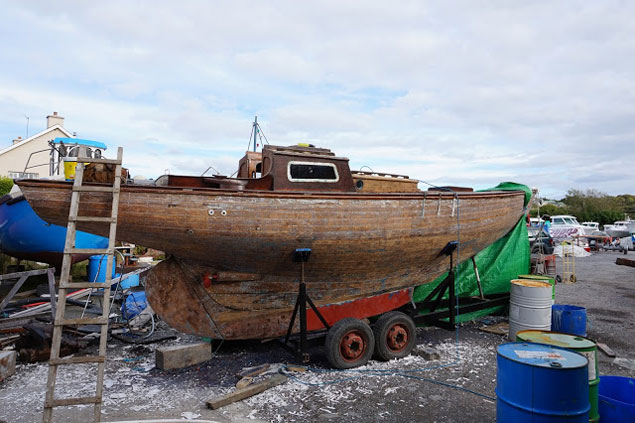 This is Flying Fish as she was shortly after Rui Ferreira of Ballydehob started work on her.
This is Flying Fish as she was shortly after Rui Ferreira of Ballydehob started work on her.
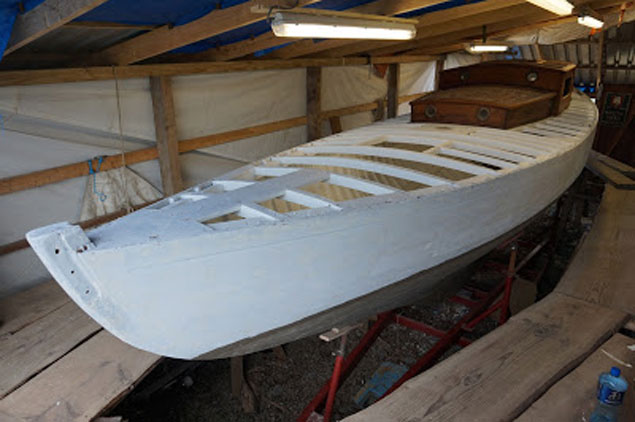 This is a more recent image of Flying Fish in Rui Ferreira’s workshop, but it is hoped that the finished restoration will be unveiled at Glandore in twelve days time.
This is a more recent image of Flying Fish in Rui Ferreira’s workshop, but it is hoped that the finished restoration will be unveiled at Glandore in twelve days time.
A sailing vessel which has punched way above her weight on Ireland’s behalf for many years now is the 76ft training schooner Spirit of Oysterhaven, and she’ll be at Glandore, an eloquent reminder of the fact that while we await government decisions on a new sail training ship, the Spirit of Oysterhaven has been gallant in filling the role in an unofficial capacity.
And in a year in which there seem to be more whales off the Irish coast than ever before, it’s more than appropriate that the fleet at Glandore will include the Irish Whale & Dolphin Group’s Research Vessel, the ketch Celtic Mist. In Glandore of all places, the sense of sea and land intertwining in a dynamic interaction is at its strongest, and Celtic Mist’s presence is reminder that our boats don’t just share the sea with other boats, we share it with an entire maritime world.
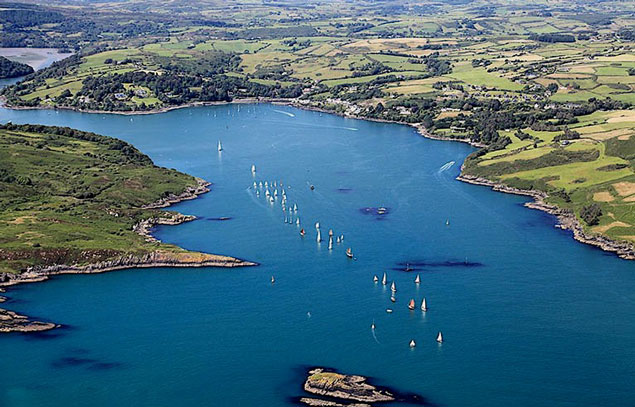 The Glandore Classic fleet on a calm day, gliding through the entrance to one of West Cork’s most beautiful inlet
The Glandore Classic fleet on a calm day, gliding through the entrance to one of West Cork’s most beautiful inlet
Tit Bonhomme 999 Concerns Will Be Considered Says Varadkar
#TitBonhomme - Transport Minister Leo Varadkar says he will consider concerns over the handling of emergency calls relating to the Tit Bonhomme tragedy, as The Irish Times reports.
The minister commented after a meeting last week with the widow of the stricken boat's skipper Michael Hayes in Union Hall in West Cork.
Hayes and four of his five-man crew lost their lives when the trawler went down after striking rocks at the mouth of Glandore Harbour. The only survivor was Egyptian fisherman Abdelbaky Mohamed, who was able to swim to shore.
The recent inquest into the incident criticised the handling of 999 emergency calls from the fishing boat prior to its sinking, as it emerged that neither the Irish Coast Guard nor the Marine Casualty Investigation Board were aware that not one but two calls were made by crewman Kevin Kershaw.
It emerged during the inquest that the coastguard was only notified of the event on the second call, three minutes after the first.
Barrister Elizabeth O'Connel, who represented Hayes' widow Caitlín Uí Aodha at the inquest, described the dearth of details taken by the operator on the first call as "extraordinary".
Ireland's emergency call service, operated by BT Ireland from three locations, is currently under review by the Department of Communications.
The Irish Times has more on the story HERE.
Tit Bonhomme Inquest Criticises 999 Service
#TitBonhomme - The "extraordinary" lack of information solicited by the operator who took the first of two emergency calls from the sinking Tit Bonhomme has been taken to task at the inquest into the loss of the trawler's crew.
The Irish Times reports that it only emerged last week that two emergency calls were made from the vessel by its youngest crew member Kevin Kershaw, though the Irish Coast Guard and the Marine Casualty Investigation Board (MCIB) were previously aware of only one.
The first - and previously unreported - 999 call from Kershaw's mobile phone at 5.46am was transferred to Bandon Garda Station rather than to the coastguard. Barrister Elizabeth O'Connel, representing the widow of skipper Michael Hayes, described the dearth of details taken by the operator on that call as "extraordinary".
It was only on the second call placed three minutes later that the Irish Guard was notified of the incident by 5.53am.
The Department of Communications has since announced it will conduct a review of the 999 service provided by the Emergency Call Answering Service (Ecas), operated by BT Ireland from Ballyshannon, Navan and Dublin.
As previously reported on Afloat.ie, five fishermen lost their lives when the trawler Tit Bonhomme went down after striking rocks at the mouth of Glandore Harbour.
The only survivor, Abdelbaky Mohamed, gave testimony to the inquest two weeks ago of his last moments aboard the stricken vessel.


























